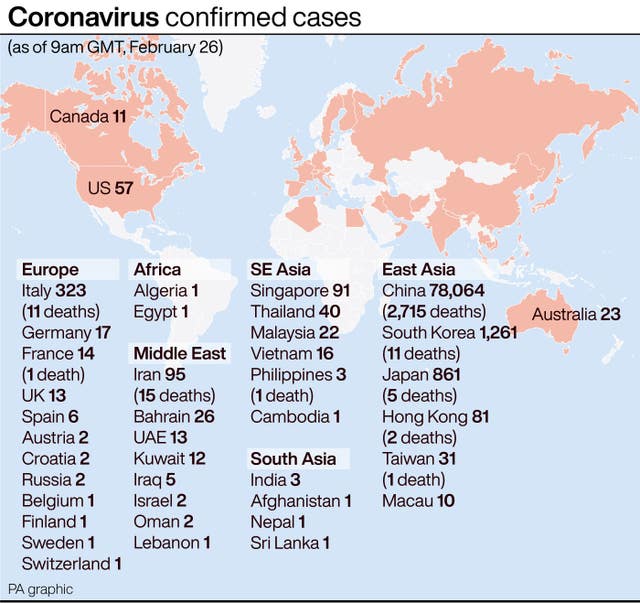
South Korean virus cases of the coronavirus have jumped again, as the US military confirmed its first case among American soldiers based in the Asian country.
Most of the new cases are connected to the south-eastern city of Daegu, with a growing illness cluster.
South Korea’s Centres for Disease Control and Prevention said 216 of the 284 new cases were in Daegu, where the government has been mobilising public health services to contain the spread of the outbreak, and in neighbouring towns.

The US military said the 23-year-old soldier was in self-quarantine at his off-base residence. He had been based in Camp Carroll in a town near Daegu, and visited both Carroll and nearby Camp Walker in recent days.
South Korean authorities and US military health professionals are tracing his contacts to determine if other people may have been exposed.
About 28,500 US troops are stationed in South Korea as deterrence against potential aggression from North Korea.
United States Forces Korea (USFK) previously said a widowed dependent had the virus, the first case involving a USFK-related individual.
South Korea’s 600,000-member military has reported 18 cases and quarantined thousands of soldiers as a precaution.

Bowling alleys, movie theatres and a golf course at four US bases were closed after the soldier’s case was confirmed, according to Col Edward Ballanco, commander of the US Army Garrison Daegu.
All restaurants at the bases, and at Camp George in Daegu, could now provide only takeaway meals with soldiers and family members prohibited from dining there, he said.
South Korea now has 1,261 confirmed infections of the virus and 11 fatalities from the Covid-19 illness it causes.
The national government has been channelling medical personnel, protective suits and other supplies to Daegu, and there are concerns the local hospitals are being overwhelmed and fatigued doctors are becoming vulnerable to infections.

“This week will be critical in the fight to combat the illness,” Prime Minister Chung Se-kyun said at a meeting in Daegu City Hall to discuss quarantine efforts.
The number of cases were expected to rise as health workers finish testing hundreds of members of the Daegu branch of a church that has the country’s biggest cluster of infections.
The Shincheonji Church of Jesus, which mainstream Christian organisations describe as a cult, provided a list of 212,000 members nationwide to government authorities who plan to widen the screening.
Vice health minister Kim Gang-lip said authorities plan to find and test churchgoers exhibiting symptoms first.
South Korea’s virus patients also include a 25-year-old cabin crew member of Korean Air, the country’s biggest airline, who worked on a flight that departed from Israel and arrived in South Korea on February 16, officials said. The flight also carried a group of tourists, of which 30 have tested positive.

China, by far, still has the most cases and deaths from the illness, though its daily increase in cases has slowed recently.
Chinese officials reported another 406 cases and 52 additional deaths, all of them in hard-hit Hubei province and all but 10 in the epicentre of the city of Wuhan.
China has recorded 2,715 deaths from Covid-19 and 78,064 confirmed cases of the virus on the mainland since the illness emerged in December.
The country has put Wuhan and nearby cities under virtual quarantine for weeks, halting nearly all movement except for disease prevention, health care and supplying necessities.
Uncertainly remains over how best to stem the spread of the illness. Italy had taken Europe’s most stringent preventative measures, and yet became home to the biggest outbreak outside Asia.

Experts in Japan acknowledged the mishandling of a virus-stricken cruise ship could have allowed the problem to magnify.
Several Middle Eastern countries reported jumps in cases tied to travel from Iran, which has the highest death toll outside of China with 19 killed amid 139 cases confirmed on Wednesday.
Iranian health ministry spokesman Kianoush Jahanpour has urged citizens to avoid “non-essential travel”, particularly to the hard-hit provinces of the country such as Gilan and Qom.
Iranian president Hassan Rouhani said Tehran has no immediate plans to quarantine cities over the outbreak, but he acknowledged it may take “one, two or three weeks” to get control of the virus in the country.
Among the cases in Iran is the top official in charge of the nation’s response to the outbreak. He tested positive for the illness a day after trying to downplay the outbreak.
Kuwait’s KUNA news agency said 12 cases have been confirmed there, and Bahrain’s state-run news agency said it had 26 cases.
Japan’s total of 861, third highest behind China and South Korea, includes 691 from the Diamond Princess liner.
Four former passengers on the ship have died and more than a dozen people who were evacuated by their home countries later tested positive for the virus.
Six government officials involved in the quarantine effort also became sick.


Comments: Our rules
We want our comments to be a lively and valuable part of our community - a place where readers can debate and engage with the most important local issues. The ability to comment on our stories is a privilege, not a right, however, and that privilege may be withdrawn if it is abused or misused.
Please report any comments that break our rules.
Read the rules here